简介
按照上一篇的计划,这一篇给小伙伴们讲解一下:(1)多模块使用logging,(2)通过文件配置logging模块,(3)自己封装一个日志(logging)类。可能有的小伙伴在这里会有个疑问一个logging为什么分两篇的篇幅来介绍她呢???那是因为日志是非常重要的,用于记录系统、软件操作事件的记录文件或文件集合,可分为事件日志和消息日志。具有处理历史数据、诊断问题的追踪以及理解系统、软件的活动等重要作用,在开发或者测试软系统过程中出现了问题,我们首先想到的就是她——logging。她可不像泰戈尔说的:“天空没有留下翅膀的痕迹,但我已经飞过”;这个90后的小姑娘,她可是一个爱炫耀,爱显摆的人已经达到了人过留名、雁过留声的境界。好了逗大家一乐,下面开始进入今天的正题。
多模块使用logging
1、父模块fatherModule.py:

2、子模块sonModule.py:
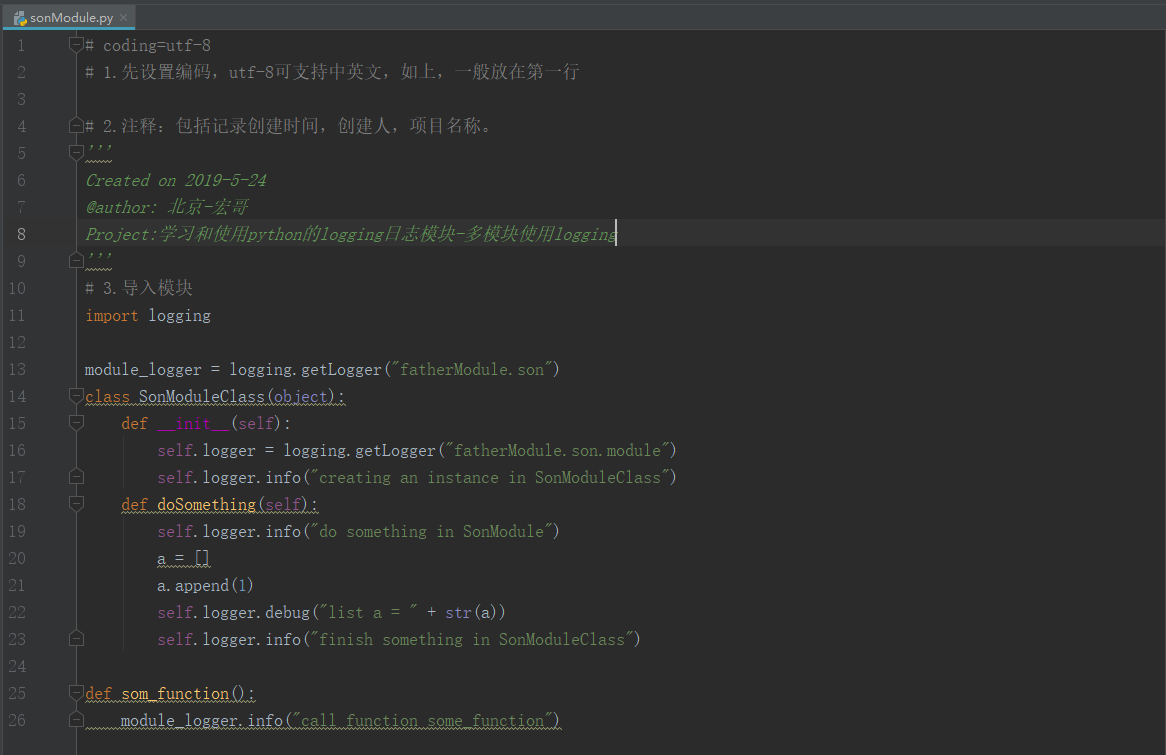
3、运行结果,在控制和日志文件log.txt中输出:
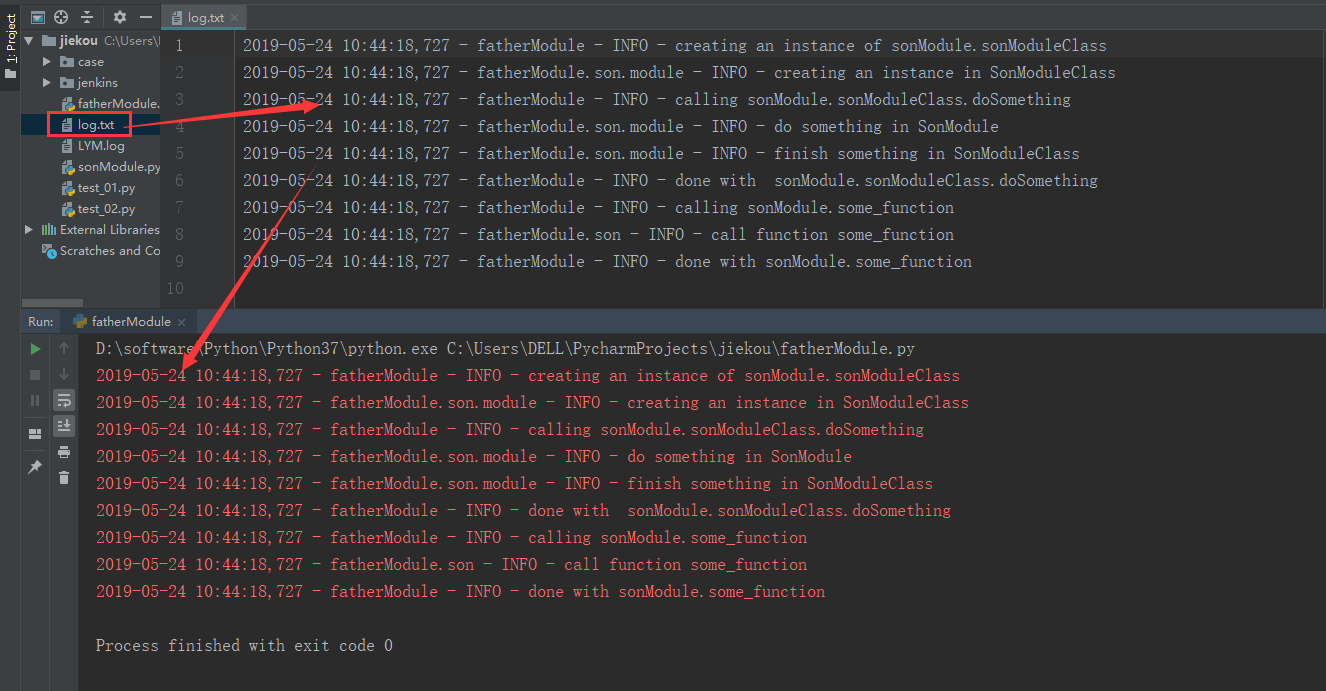
首先在父模块定义了logger'fatherModule',并对它进行了配置,就可以在解释器进程里面的其他地方通过getLogger('fatherModule')得到的对象都是一样的,不需要重新配置,可以直接使用。定义的该logger的子logger,
都可以共享父logger的定义和配置,所谓的父子logger是通过命名来识别,任意以'fatherModule'开头的logger都是它的子logger,例如'fatherModule.son'。
实际开发一个application,首先可以通过logging配置文件编写好这个application所对应的配置,可以生成一个根logger,如'PythonAPP',然后在主函数中通过fileConfig加载logging配置,接着在application的其他地方、不同的模块中,可以使用根logger的子logger,
如'PythonAPP.Core','PythonAPP.Web'来进行log,而不需要反复的定义和配置各个模块的logger。
4、参考代码
fatherModule.py文件:
1 # coding=utf-8 2 # 1.先设置编码,utf-8可支持中英文,如上,一般放在第一行 3 4 # 2.注释:包括记录创建时间,创建人,项目名称。 5 ''' 6 Created on 2019-5-24 7 @author: 北京-宏哥 8 Project:学习和使用python的logging日志模块-多模块使用logging 9 ''' 10 # 3.导入模块 11 import logging 12 import sonModule 13 logger = logging.getLogger("fatherModule") 14 logger.setLevel(level = logging.INFO) 15 handler = logging.FileHandler("log.txt") 16 handler.setLevel(logging.INFO) 17 formatter = logging.Formatter('%(asctime)s - %(name)s - %(levelname)s - %(message)s') 18 handler.setFormatter(formatter) 19 20 console = logging.StreamHandler() 21 console.setLevel(logging.INFO) 22 console.setFormatter(formatter) 23 24 logger.addHandler(handler) 25 logger.addHandler(console) 26 27 28 logger.info("creating an instance of sonModule.sonModuleClass") 29 a = sonModule.SonModuleClass() 30 logger.info("calling sonModule.sonModuleClass.doSomething") 31 a.doSomething() 32 logger.info("done with sonModule.sonModuleClass.doSomething") 33 logger.info("calling sonModule.some_function") 34 sonModule.som_function() 35 logger.info("done with sonModule.some_function")
sonModule.py文件:
1 # coding=utf-8 2 # 1.先设置编码,utf-8可支持中英文,如上,一般放在第一行 3 4 # 2.注释:包括记录创建时间,创建人,项目名称。 5 ''' 6 Created on 2019-5-24 7 @author: 北京-宏哥 8 Project:学习和使用python的logging日志模块-多模块使用logging 9 ''' 10 # 3.导入模块 11 import logging 12 13 module_logger = logging.getLogger("fatherModule.son") 14 class SonModuleClass(object): 15 def __init__(self): 16 self.logger = logging.getLogger("fatherModule.son.module") 17 self.logger.info("creating an instance in SonModuleClass") 18 def doSomething(self): 19 self.logger.info("do something in SonModule") 20 a = [] 21 a.append(1) 22 self.logger.debug("list a = " + str(a)) 23 self.logger.info("finish something in SonModuleClass") 24 25 def som_function(): 26 module_logger.info("call function some_function")
文件配置logging模块
1、通过logging.config模块配置日志构造信息
logger.conf文件:
[loggers] keys = root, example01, example02 [logger_root] level = DEBUG handlers = hand01, hand02 [logger_example01] handlers = hand01, hand02 qualname = example01 propagate = 0 [logger_example02] handlers = hand01, hand03 qualname = example02 propagate = 0 [handlers] keys = hand01, hand02, hand03 [handler_hand01] class = StreamHandler level = INFO formatter = form01 args=(sys.stdout, ) [handler_hand02] class = FileHandler level = DEBUG formatter = form01 args = ('log/test_case_log.log', 'a') [handler_hand03] class = handlers.RotatingFileHandler level = INFO formatter = form01 args = ('log/test_case_log.log', 'a', 10*1024*1024,3) [formatters] keys = form01, form02 [formatter_form01] format = %(asctime)s-%(filename)s-[line:%(lineno)d]-%(levelname)s-[LogInfoMessage]: %(message)s datefmt = %a, %d %b %Y %H:%M:%S [formatter_form02] format = %(name)-12s: %(levelname)-8s-[日志信息]: %(message)s datefmt = %a, %d %b %Y %H:%M:%S
一、实例:
1、实例代码
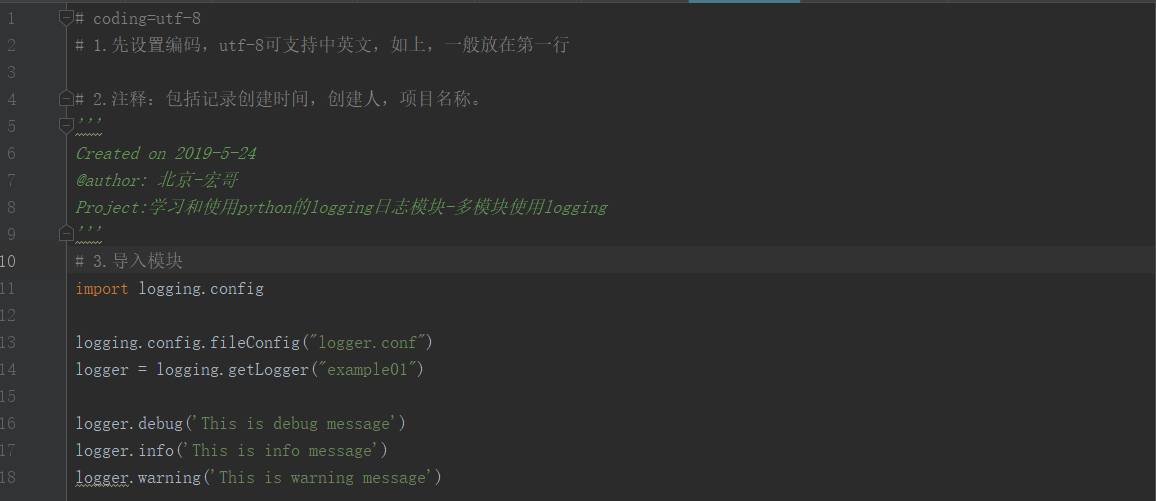
2、运行结果:

3、参考代码:
# coding=utf-8 # 1.先设置编码,utf-8可支持中英文,如上,一般放在第一行 # 2.注释:包括记录创建时间,创建人,项目名称。 ''' Created on 2019-5-27 @author: 北京-宏哥 Project:学习和使用python的logging日志模块-多模块使用logging ''' # 3.导入模块 import logging import logging.config logging.config.fileConfig("logger.conf") logger = logging.getLogger("example01") logger.debug('This is debug message') logger.info('This is info message') logger.warning('This is warning message')
二、实例
1、实例代码
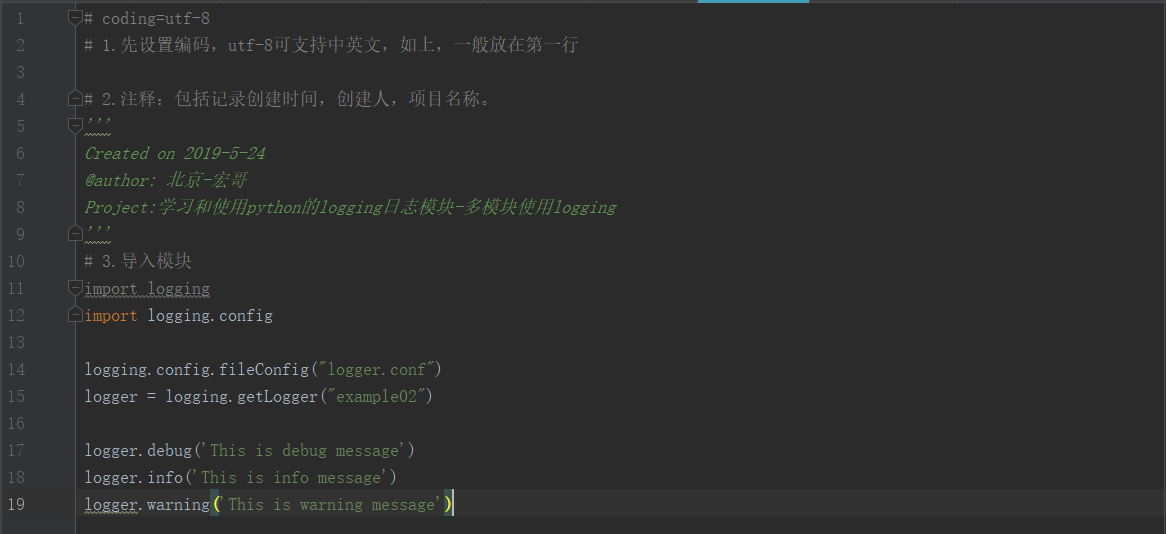
2、运行结果

3、参考代码:
# coding=utf-8 # 1.先设置编码,utf-8可支持中英文,如上,一般放在第一行 # 2.注释:包括记录创建时间,创建人,项目名称。 ''' Created on 2019-5-24 @author: 北京-宏哥 Project:学习和使用python的logging日志模块-多模块使用logging ''' # 3.导入模块 import logging import logging.config logging.config.fileConfig("logger.conf") logger = logging.getLogger("example02") logger.debug('This is debug message') logger.info('This is info message') logger.warning('This is warning message')
2、通过JSON文件配置
json配置文件:
{ "version":1, "disable_existing_loggers":false, "formatters":{ "simple":{ "format":"%(asctime)s - %(name)s - %(levelname)s - %(message)s" } }, "handlers":{ "console":{ "class":"logging.StreamHandler", "level":"DEBUG", "formatter":"simple", "stream":"ext://sys.stdout" }, "info_file_handler":{ "class":"logging.handlers.RotatingFileHandler", "level":"INFO", "formatter":"simple", "filename":"info.log", "maxBytes":"10485760", "backupCount":20, "encoding":"utf8" }, "error_file_handler":{ "class":"logging.handlers.RotatingFileHandler", "level":"ERROR", "formatter":"simple", "filename":"errors.log", "maxBytes":10485760, "backupCount":20, "encoding":"utf8" } }, "loggers":{ "my_module":{ "level":"ERROR", "handlers":["info_file_handler"], "propagate":"no" } }, "root":{ "level":"INFO", "handlers":["console","info_file_handler","error_file_handler"] } }
1、通过JSON加载配置文件,然后通过logging.dictConfig配置logging:
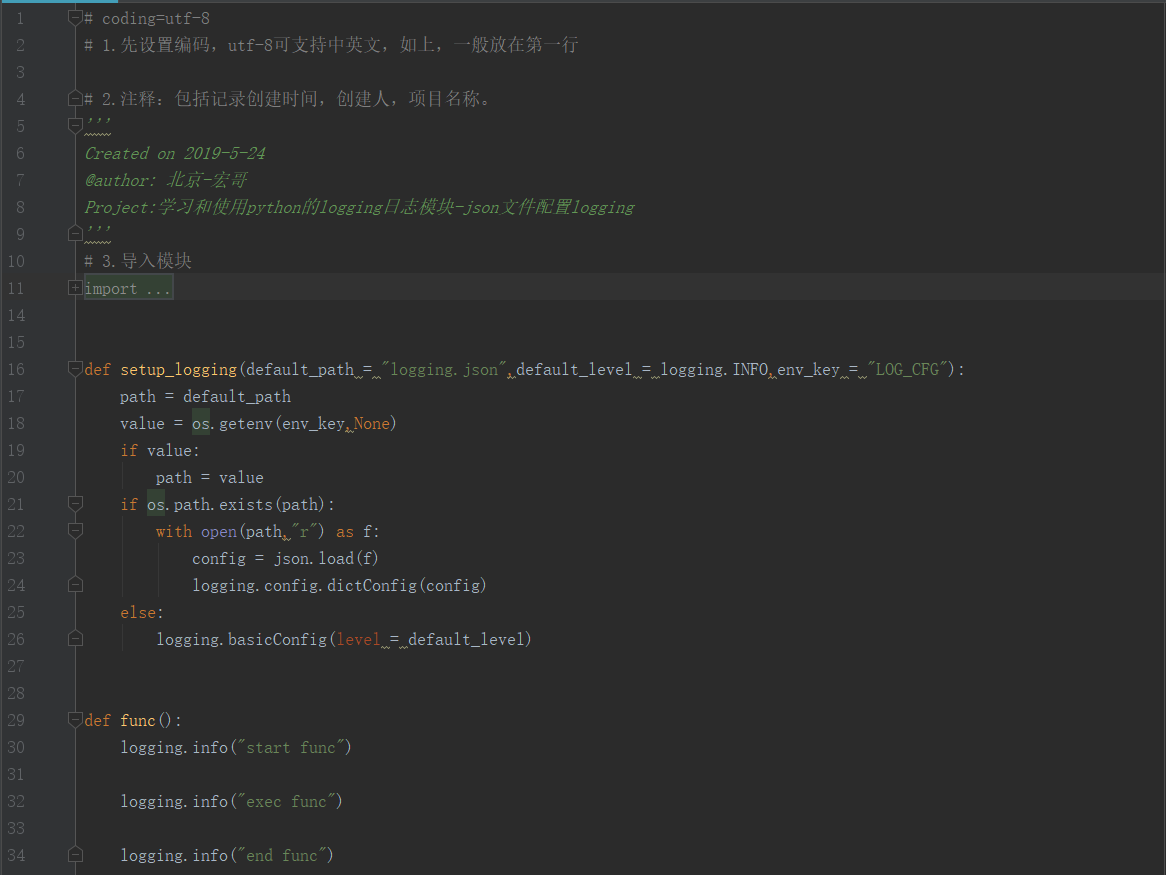
2、运行结果:

3、参考代码:
1 import json
2 import logging.config
3 import os
4
5 def setup_logging(default_path = "logging.json",default_level = logging.INFO,env_key = "LOG_CFG"):
6 path = default_path
7 value = os.getenv(env_key,None)
8 if value:
9 path = value
10 if os.path.exists(path):
11 with open(path,"r") as f:
12 config = json.load(f)
13 logging.config.dictConfig(config)
14 else:
15 logging.basicConfig(level = default_level)
16
17 def func():
18 logging.info("start func")
19
20 logging.info("exec func")
21
22 logging.info("end func")
23
24 if __name__ == "__main__":
25 setup_logging(default_path = "logging.json")
26 func()
3、通过YAML文件配置
1、首先要导入yaml模块,输入命令 python2: pip install yaml python3:pip install pyyaml

2、通过YAML文件进行配置,比JSON看起来更加简介明了:
logging.yaml文件:
version: 1 disable_existing_loggers: False formatters: simple: format: "%(asctime)s - %(name)s - %(levelname)s - %(message)s" handlers: console: class: logging.StreamHandler level: DEBUG formatter: simple stream: ext://sys.stdout info_file_handler: class: logging.handlers.RotatingFileHandler level: INFO formatter: simple filename: info.log maxBytes: 10485760 backupCount: 20 encoding: utf8 error_file_handler: class: logging.handlers.RotatingFileHandler level: ERROR formatter: simple filename: errors.log maxBytes: 10485760 backupCount: 20 encoding: utf8 loggers: my_module: level: ERROR handlers: [info_file_handler] propagate: no root: level: INFO handlers: [console,info_file_handler,error_file_handler]
3、通过YAML加载配置文件,然后通过logging.dictConfig配置logging:

4、运行结果:

5、参考代码:
# coding=utf-8 # 1.先设置编码,utf-8可支持中英文,如上,一般放在第一行 # 2.注释:包括记录创建时间,创建人,项目名称。 ''' Created on 2019-5-24 @author: 北京-宏哥 Project:学习和使用python的logging日志模块-yaml文件配置logging ''' # 3.导入模块 import yaml import logging.config import os def setup_logging(default_path = "logging.yaml",default_level = logging.INFO,env_key = "LOG_CFG"): path = default_path value = os.getenv(env_key,None) if value: path = value if os.path.exists(path): with open(path,"r") as f: config = yaml.load(f) logging.config.dictConfig(config) else: logging.basicConfig(level = default_level) def func(): logging.info("start func") logging.info("exec func") logging.info("end func") if __name__ == "__main__": setup_logging(default_path = "logging.yaml") func()
注意:配置文件中“disable_existing_loggers” 参数设置为 False;如果不设置为False,创建了 logger,然后你又在加载日志配置文件之前就导入了模块。logging.fileConfig 与 logging.dictConfig 默认情况下会使得已经存在的 logger 失效。那么,这些配置信息就不会应用到你的 Logger 上。“disable_existing_loggers” = False解决了这个问题
自己封装一个logging类
1、实例代码:
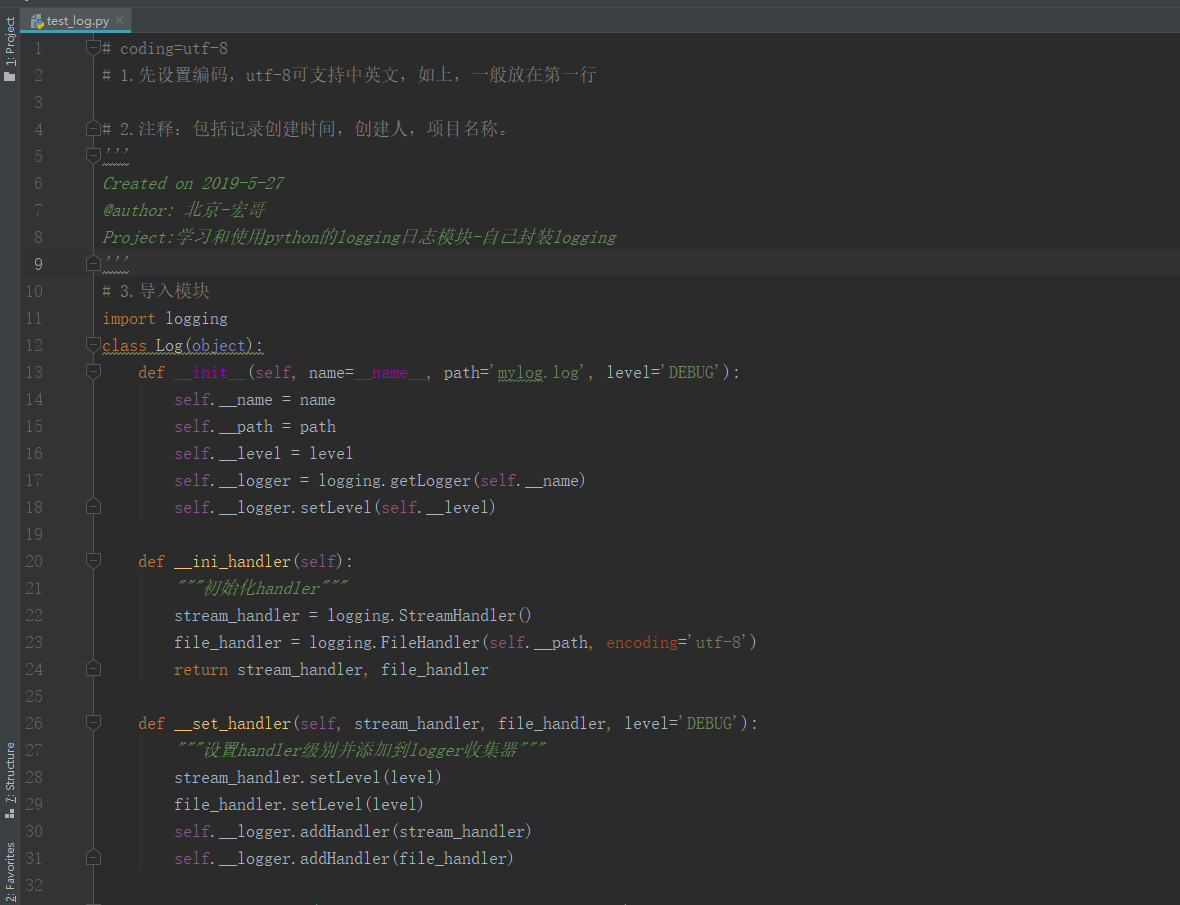
2、运行结果:

3、参考代码:
1 # coding=utf-8 2 # 1.先设置编码,utf-8可支持中英文,如上,一般放在第一行 3 4 # 2.注释:包括记录创建时间,创建人,项目名称。 5 ''' 6 Created on 2019-5-27 7 @author: 北京-宏哥 8 Project:学习和使用python的logging日志模块-自己封装logging 9 ''' 10 # 3.导入模块 11 import logging 12 class Log(object): 13 def __init__(self, name=__name__, path='mylog.log', level='DEBUG'): 14 self.__name = name 15 self.__path = path 16 self.__level = level 17 self.__logger = logging.getLogger(self.__name) 18 self.__logger.setLevel(self.__level) 19 20 def __ini_handler(self): 21 """初始化handler""" 22 stream_handler = logging.StreamHandler() 23 file_handler = logging.FileHandler(self.__path, encoding='utf-8') 24 return stream_handler, file_handler 25 26 def __set_handler(self, stream_handler, file_handler, level='DEBUG'): 27 """设置handler级别并添加到logger收集器""" 28 stream_handler.setLevel(level) 29 file_handler.setLevel(level) 30 self.__logger.addHandler(stream_handler) 31 self.__logger.addHandler(file_handler) 32 33 def __set_formatter(self, stream_handler, file_handler): 34 """设置日志输出格式""" 35 formatter = logging.Formatter('%(asctime)s-%(name)s-%(filename)s-[line:%(lineno)d]' 36 '-%(levelname)s-[日志信息]: %(message)s', 37 datefmt='%a, %d %b %Y %H:%M:%S') 38 stream_handler.setFormatter(formatter) 39 file_handler.setFormatter(formatter) 40 41 def __close_handler(self, stream_handler, file_handler): 42 """关闭handler""" 43 stream_handler.close() 44 file_handler.close() 45 46 @property 47 def Logger(self): 48 """构造收集器,返回looger""" 49 stream_handler, file_handler = self.__ini_handler() 50 self.__set_handler(stream_handler, file_handler) 51 self.__set_formatter(stream_handler, file_handler) 52 self.__close_handler(stream_handler, file_handler) 53 return self.__logger 54 55 56 if __name__ == '__main__': 57 log = Log(__name__, 'file.log') 58 logger = log.Logger 59 logger.debug('I am a debug message') 60 logger.info('I am a info message') 61 logger.warning('I am a warning message') 62 logger.error('I am a error message') 63 logger.critical('I am a critical message')
小结
1、在yaml文件配置logging的时候,会有个报警信息。有代码洁癖的人,可以处理一下

2、是什么原因造成上面的告警呢???是因为:YAML 5.1版本后弃用了yaml.load(file)这个用法,因为觉得很不安全,5.1版本之后就修改了需要指定Loader,通过默认加载器(FullLoader)禁止执行任意函数,该load函数也变得更加安全。
3、解决办法:
不用改很多代码 加一句就行了 在yaml.load(f, Loader=yaml.FullLoader) 加上 Loader=yaml.FullLoader 就行了。这里要注意的是L要大写的,否则会报错的。
4、加上以后,看一下运行结果:
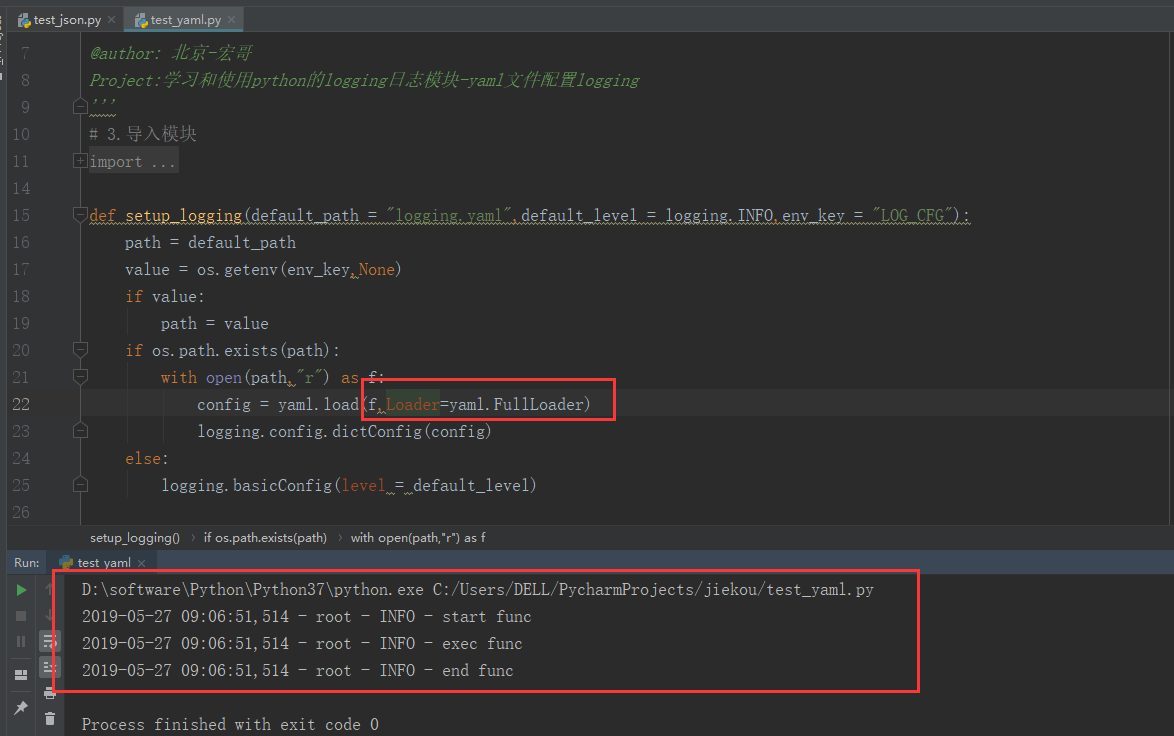
最后给大家留个彩蛋:文章中有一处bug,会影响运行结果而报错,聪明的你,可以找到吗???嘿嘿!!!欢迎互动和留言